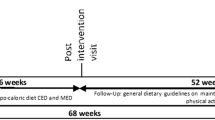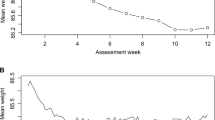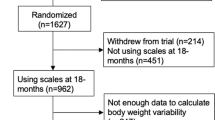Abstract
OBJECTIVE: This study analyzed baseline behavioral and psychosocial differences between successful and nonsuccessful participants in a behavioral weight management program. Success was defined by commonly used health-related criteria (5% weight loss). Noncompletion was also used as a marker of a failed attempt at weight control.
SUBJECTS: A total of 158 healthy overweight and obese women (age, 48.0±4.5 y; BMI, 31.0±3.8 kg/m2; body fat, 44.5±5.3%).
INTERVENTION: Subjects participated in a 16-week lifestyle weight loss program consisting of group-based behavior therapy to improve diet and increase physical activity, and were followed for 1 y after treatment.
METHODS: At baseline, all women completed a comprehensive behavioral and psychosocial battery assessing dieting/weight history, dietary intake and eating behaviors, exercise, self-efficacy, outcome evaluations, body image, and other variables considered relevant for weight management. Participants who maintained a weight loss of 5% or more at 16 months (or 10% or more of initial fat mass) were classified as successful. Nonsuccessful participants were those who dropped out and completers who had not lost weight at follow-up.
RESULTS: Of all participants, 30% (n=47) did not complete initial treatment and/or missed follow-up assessments (noncompleters). Noncompletion was independently associated with more previous weight loss attempts, poorer quality of life, more stringent weight outcome evaluations, and lower reported carbohydrate intake at baseline. In logistic regression, completion status was predicted correctly in 84% of all cases (χ2=45.5, P<0.001), using baseline information only. Additional predictors of attrition were initial weight, exercise minutes, fiber intake, binge eating, psychological health, and body image. A large variation in weight loss/maintenance results was observed (range: 37.2 kg for 16-month weight change). Independent baseline predictors of success at 16 months were more moderate weight outcome evaluations, lower level of previous dieting, higher exercise self-efficacy, and smaller waist-to-hip ratio. Success status at follow-up was predicted correctly in 74% of all starting cases (χ2=33.6, P<0.001).
CONCLUSION: Psychosocial and behavioral variables (eg, dieting history, dietary intake, outcome evaluations, exercise self-efficacy, and quality of life) may be useful as pretreatment predictors of success level and/or attrition in previously overweight and mildly obese women who volunteer for behavioral weight control programs. These factors can be used in developing readiness profiles for weight management, a potentially important tool to address the issue of low success/completion rates in the current management of obesity.
This is a preview of subscription content, access via your institution
Access options
Subscribe to this journal
Receive 12 print issues and online access
$259.00 per year
only $21.58 per issue
Buy this article
- Purchase on Springer Link
- Instant access to full article PDF
Prices may be subject to local taxes which are calculated during checkout


Similar content being viewed by others
References
Jeffery RW, Drewnowski A, Epstein LH, Stunkard AJ, Wilson GT, Wing RR, Hill DR . Long-term maintenance of weight loss: current status. Health Psychol 2000; 19: 5–16.
Anderson JW, Konz EC, Frederich RC, Wood CL . Long-term weight-loss maintenance: a meta-analysis of US studies. Am J Clin Nutr 2001; 74: 579–584.
Wing RR . Behavioral interventions for obesity: recognizing our progress and future challenges. Obes Res 2003; 11 (Suppl 1): 3S–6S.
Wing RR, Jeffery RW . Benefits of recruiting participants with friends and increasing social support for weight loss and maintenance. J Consult Clin Psychol 1999; 67: 132–138.
Kiernan M, King AC, Kraemer HC, Stefanick ML, Killen JD . Characteristics of successful and unsuccessful dieters: an application of signal detection methodology. Ann Behav Med 1998; 20: 1–6.
Bernier M, Avard J . Self-efficacy, outcome and attrition in a weight-reduction program. Cogn Ther Res 1986; 10: 319–338.
Beliard D, Kirschenbaum DS, Fitzgibbon ML . Evaluation of an intensive weight control program using a priori criteria to determine outcome. Int J Obes Relat Metab Disord 1992; 16: 505–517.
Traverso A, Ravera G, Lagattolla V, Testa S, Adami GF . Weight loss after dieting with behavioral modification for obesity: the predicting efficiency of some psychometric data. Eat Weight Disord 2000; 5: 102–107.
Dennis KE, Goldberg AP . Weight control self-efficacy types and transitions affect weight-loss outcomes in obese women. Addict Behav 1996; 21: 103–116.
Williams GC, Grow VM, Freedman ZR, Ryan RM, Deci EL . Motivational predictors of weight loss and weight-loss maintenance. J Pers Soc Psychol 1996; 70: 115–126.
Teixeira PJ, Going SB, Houtkooper LB, Cussler EC, Martin CJ, Metcalfe LL, Finkenthal NR, Blew RM, Sardinha LB, Lohman TG . Weight loss readiness in middle-aged women: psychosocial predictors of success for behavioral weight reduction. J Behav Med 2002; 25: 499–523.
Institute of Medicine. Weighing the Options: Criteria for Evaluating Weight-Management Programs. National Academy Press: Washington, DC; 1995.
Sallis JF, Haskell WL, Wood PD, Fortmann SP, Rogers T, Blair SN, Paffenbarger Jr RS . Physical activity assessment methodology in the Five-City Project. Am J Epidemiol 1985; 121: 91–106.
Foster GD, Wadden TA, Vogt RA, Brewer G . What is a reasonable weight loss? Patients’ expectations and evaluations of obesity treatment outcomes. J Consult Clin Psychol 1997; 65: 79–85.
Ware J, Snow K, Kosinski M, Gandek B . SF-36 Health Survey Manual and Interpretation Guide. New England Medical Center, The Health Institute: Boston, MA; 1993.
Kolotkin RL, Crosby RD . Psychometric evaluation of the Impact of Weight on Quality of Life-Lite Questionnaire (IWQOL-lite) in a community sample. Qual Life Res 2002; 11: 157–171.
Sherbourne CD, Stewart AL . The MOS social support survey. Soc Sci Med 1991; 32: 705–714.
Beck AT, Steer RA . Manual for the Beck Depression Inventory. Psychological Corporation: New York; 1987.
Rosenberg M . Society and the Adolescent Self-image. Princeton University Press: Princeton, NJ; 1965.
Dishman RK, Ickes W . Self-motivation and adherence to therapeutic exercise. J Behav Med 1981; 4: 421–438.
Gormally J, Black S, Daston S, Rardin D . The assessment of binge eating severity among obese persons. Addict Behav 1982; 7: 47–55.
Glynn SM, Ruderman AJ . The development and validation of an eating self-efficacy scale. Cogn Ther Res 1986; 10: 403–420.
Stunkard AJ, Messick S . The three-factor eating questionnaire to measure dietary restraint, disinhibition and hunger. J Psychosom Res 1985; 29: 71–83.
Sallis JF, Pinski MA, Grossman RB, Patterson TL, Nader PR . The development of self-efficacy scales for health-related diet and exercise behaviors. Health Educ Res 1988; 3: 283–292.
Steinhardt MA, Dishman RK . Reliability and validity of expected outcomes and barriers for habitual physical activity. J Occup Med 1989; 31: 536–546.
Sallis JF, Grossman RM, Pinski RB, Patterson TL, Nader PR . The development of scales to measure social support for diet and exercise behaviors. Prev Med 1987; 16: 825–836.
Cooper PJ, Taylor MJ, Cooper Z, Fairburn CG . The development and validation of a body shape questionnaire. Int J Eating Disord 1987; 6: 485–494.
Williamson DA, Gleaves DH, Watkins PC, Schlundt DG . Validation of a self-ideal body size discrepancy as a measure of body size dissatisfaction. J Psychol Behav Assess 1993; 15 (Suppl 1): 57–68.
Secord S, Jourard P . The appraisal of body cathexis: Body cathexis and the self. J Consult Psych 1953; 17: 343–347.
Wing RR . Behavioral weight control. In: Wadden TA, Stunkard AJ (eds) Handbook of obesity treatment. The Guilford Press: New York; 2002. pp. 301–316.
Gadbury GL, Coffey CS, Allison DB . Modern statistical methods for handling missing repeated measurements in obesity trial data: beyond LOCF. Obes Rev 2003; 4: 175–184.
Ware JH . Interpreting incomplete data in studies of diet and weight loss. N Engl J Med 2003; 348: 2136–2137.
Goldstein DJ . Beneficial health effects of modest weight loss. Int J Obes Relat Metab Disord 1992; 16: 397–415.
Knowler WC, Barrett-Connor E, Fowler SE, Hamman RF, Lachin JM, Walker EA, Nathan DM . Reduction in the incidence of type 2 diabetes with lifestyle intervention or metformin. N Engl J Med 2002; 346: 393–403.
Steyerberg EW, Eijkemans MJ, Harrell Jr FE, Habbema JD . Prognostic modelling with logistic regression analysis: a comparison of selection and estimation methods in small data sets. Stat Med 2000; 19: 1059–1079.
Fowler JL, Follick MJ, Abrams DB, Rickard-Figueroa K . Participant characteristics as predictors of attrition in worksite weight loss. Addict Behav 1985; 10: 445–448.
Mitchell C, Stuart RB . Effect of self-efficacy on dropout from obesity treatment. J Consult Clin Psychol 1984; 52: 1100–1101.
Bennett GA, Jones SE . Dropping out of treatment for obesity. J Psychosom Res 1986; 30: 567–573.
Yass-Reed EM, Barry NJ, Dacey CM . Examination of pretreatment predictors of attrition in a VLCD and behavior therapy weight-loss program. Addict Behav 1993; 18: 431–435.
Marcus MD, Wing RR, Hopkins J . Obese binge eaters: affect, cognitions, and response to behavioural weight control. J Consult Clin Psychol 1988; 56: 433–439.
Ho KS, Nichaman MZ, Taylor WC, Lee ES, Foreyt JP . Binge eating disorder, retention, and dropout in an adult obesity program. Int J Eat Disord 1995; 18: 291–294.
Clark MM, Guise BJ, Niaura RS . Obesity level and attrition: support for patient-treatment matching in obesity treatment. Obes Res 1995; 3: 63–64.
Ek A, Andersson I, Barkeling B, Rossner S . Obesity treatment and attrition: no relationship to obesity level. Obes Res 1996; 4: 295–296.
Honas JJ, Early JL, Frederickson DD, O’Brien MS . Predictors of attrition in a large clinic-based weight-loss program. Obes Res 2003; 11: 888–894.
Clark MM, Niaura R, King TK, Pera V . Depression, smoking, activity level, and health status: pretreatment predictors of attrition in obesity treatment. Addict Behav 1996; 21: 509–513.
Kolotkin RL, Crosby RD, Kosloski KD, Williams GR . Development of a brief measure to assess quality of life in obesity. Obes Res 2001; 9: 102–111.
Foster GD, Wadden TA, Phelan S, Sarwer DB, Sanderson RS . Obese patients’ perceptions of treatment outcomes and the factors that influence them. Arch Intern Med 2001; 161: 2133–2139.
O’Neil PM, Smith CF, Foster GD, Anderson DA . The perceived relative worth of reaching and maintaining goal weight. Int J Obes Relat Metab Disord 2000; 24: 1069–1076.
Cooper Z, Fairburn CG . A new cognitive behavioural approach to the treatment of obesity. Behav Res Ther 2001; 39: 499–511.
Polivy J . The false hope syndrome: unrealistic expectations of self-change. Int J Obes Relat Metab Disord 2001; 25 (Suppl 1): S80–S84.
Linde JA, Jeffery RW, Finch EA, Ng DM, Rothman AJ . Are unrealistic weight loss goals associated with outcomes for overweight women? Obes Res 2004; 12: 569–576.
Weinsier RL, Nagy TR, Hunter GR, Darnell BE, Hensrud DD, Weiss HL . Do adaptive changes in metabolic rate favor weight regain in weight-reduced individuals? An examination of the set-point theory. Am J Clin Nutr 2000; 72: 1088–1094.
Food and Nutrition Board, Institute of Medicine. Dietary Reference Intakes for Energy, Carbohydrate, Fiber, Fat, Fatty Acids, Cholesterol, Protein, and Amino Acids (Macronutrients). National Academy Press: Washington, DC; 2002.
Foreyt JP, Goodrick GK . Prediction of weight management outcome: Implications for practice. In: Allison DA, Pi-Sunyer FX (eds) Obesity Treatment: Establishing Goals, Improving Outcomes, and Reviewing the Research Agenda. Plenum Press: New York; 1995. pp. 199–205.
Wadden TA, Letizia KA . Predictors of attrition and weight loss in patients treated by moderate to severe caloric restriction. In: Wadden TA, VanItallie TB (eds) Treatment of the Seriously Obese Patient. The Guilford Press: New York, NY; 1992. pp. 383–410.
Pasman WJ, Saris WH, Westerterp-Plantenga MS . Predictors of weight maintenance. Obes Res 1999; 7: 43–50.
Brownell KD . Whether obesity should be treated. Health Psychol 1993; 12: 339–341.
McGuire MT, Wing RR, Hill JO . The prevalence of weight loss maintenance among American adults. Int J Obes Relat Metab Disord 1999; 23: 1314–1319.
Vallerand RJ . A hierarchical model of intrinsic and extrinsic motivation in sport and exercise. In: Roberts GC (ed) Advances in Motivation is Sport and Exercise. Human Kinetics: Champaign, IL; 2001. pp. 263–319.
Wing RR, Jeffery RW . Prescribed ‘breaks’ as a means to disrupt weight control efforts. Obes Res 2003; 11: 287–291.
Jeffery RW, Wing RR, Sherwood NE, Tate DF . Physical activity and weight loss: does prescribing higher physical activity goals improve outcome? Am J Clin Nutr 2003; 78: 684–689.
Weiss AR . Characteristics of successful weight reducers: a brief review of predictor variables. Addict Behav 1977; 2: 193–201.
Klem ML, Wing RR, McGuire MT, Seagle HM, Hill JO . Psychological symptoms in individuals successful at long-term maintenance of weight loss. Health Psychol 1998; 17: 336–345.
USDHHS. The Practical Guide to the Identification, Evaluation, and Treatment of Overweight and Obesity in Adults. NIH—National Heart, Lung, and Blood Institute: Bethesda, MD; 2000.
Acknowledgements
This study was supported by NIH Grant DK57453.
Author information
Authors and Affiliations
Corresponding author
Rights and permissions
About this article
Cite this article
Teixeira, P., Going, S., Houtkooper, L. et al. Pretreatment predictors of attrition and successful weight management in women. Int J Obes 28, 1124–1133 (2004). https://doi.org/10.1038/sj.ijo.0802727
Received:
Revised:
Accepted:
Published:
Issue Date:
DOI: https://doi.org/10.1038/sj.ijo.0802727
Keywords
This article is cited by
-
Integrating Pharmacotherapy and Psychotherapy for Weight Loss
Journal of Health Service Psychology (2023)
-
Associations between weight loss history and factors related to type 2 diabetes risk in the Stop Diabetes study
International Journal of Obesity (2022)
-
Experienced weight stigma, internalized weight bias, and clinical attrition in a medical weight loss patient sample
International Journal of Obesity (2022)
-
Predictors of weight loss in obese patients with obstructive sleep apnea
Sleep and Breathing (2022)
-
Providing lifestyle advice to women with PCOS: an overview of practical issues affecting success
BMC Endocrine Disorders (2021)



